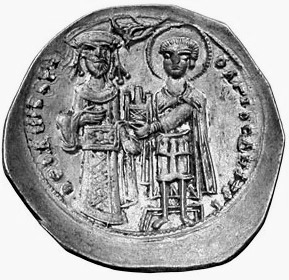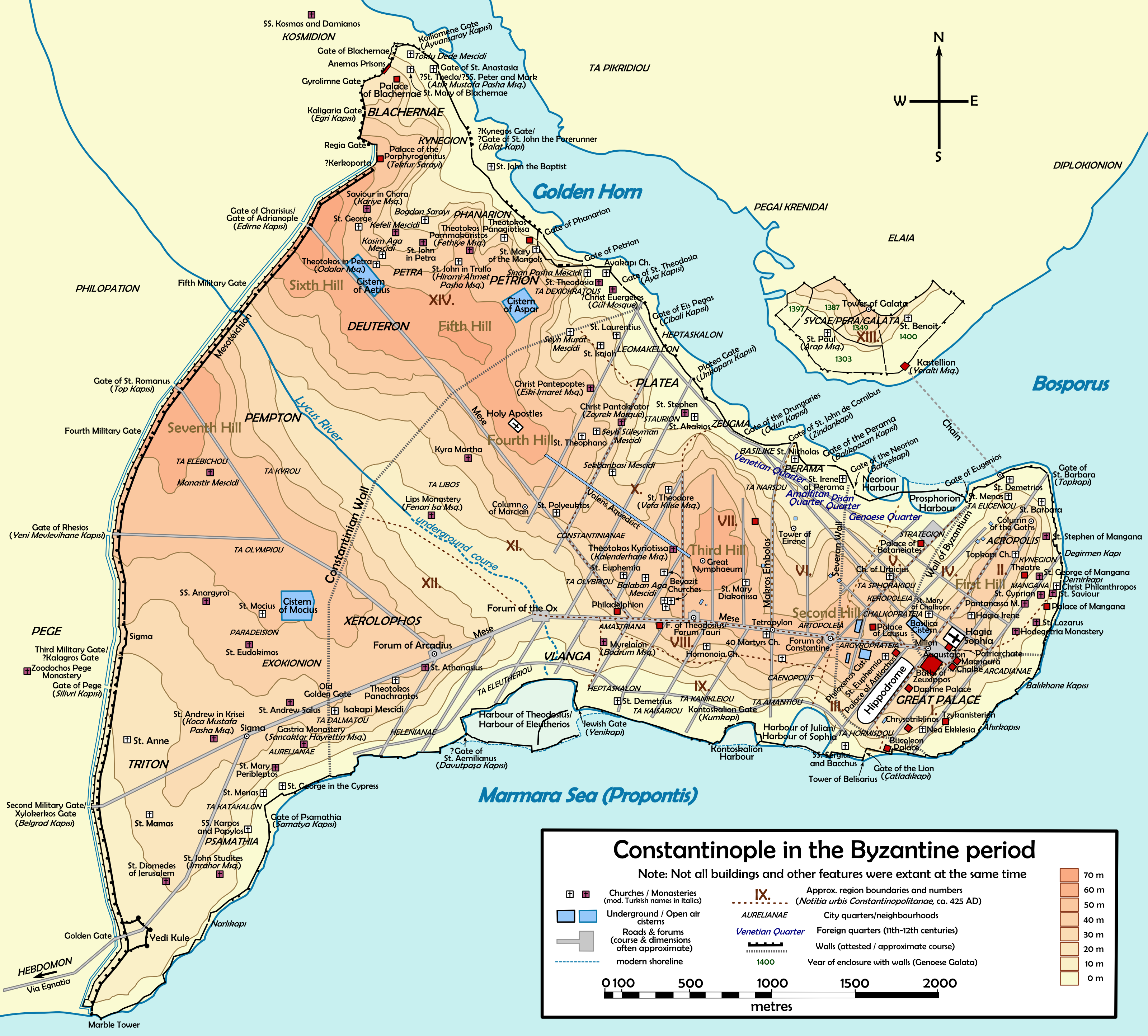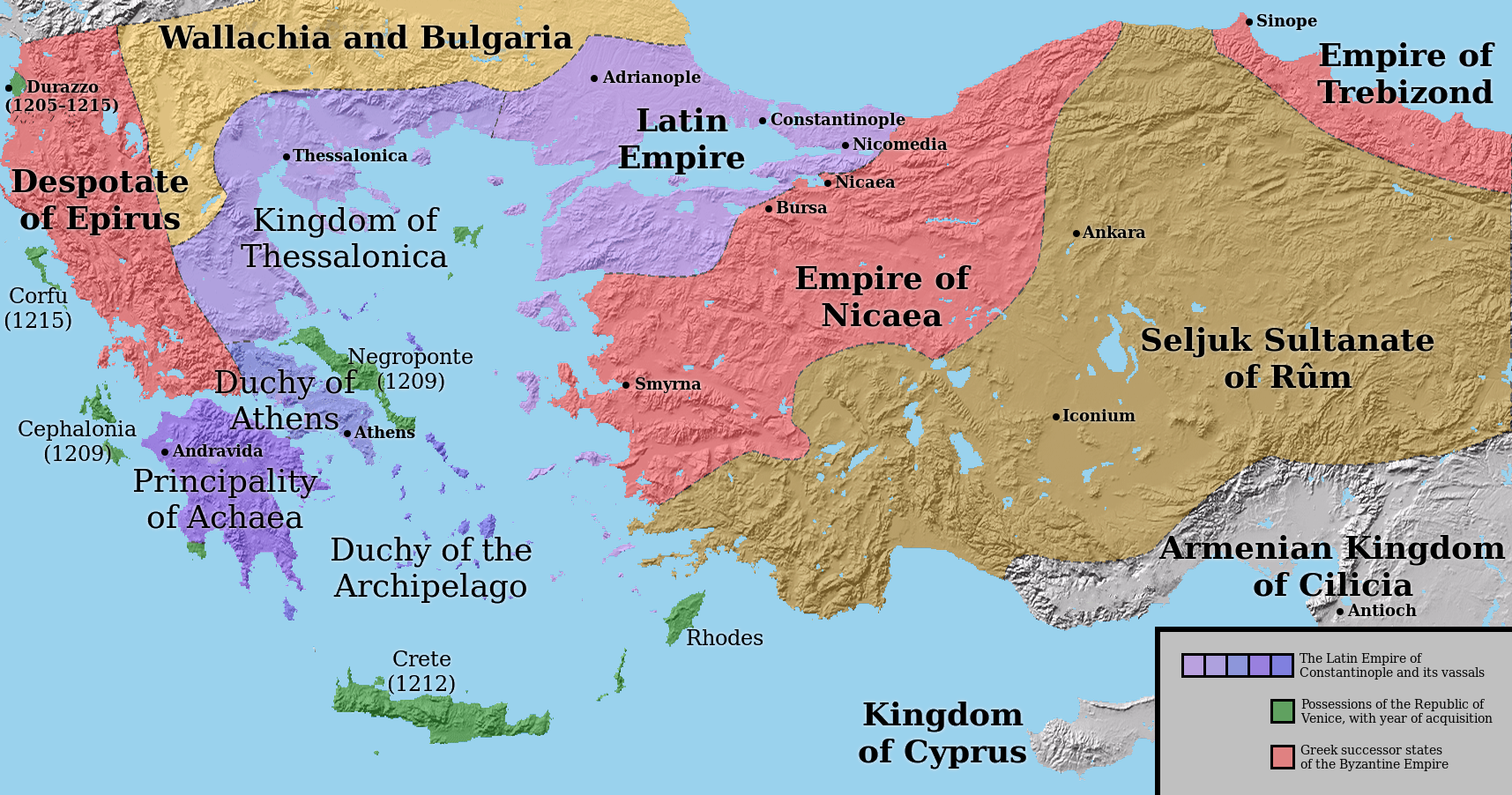|
Michael I Ducas
Michael I Komnenos Doukas, Latinized as Comnenus Ducas (), and in modern sources often recorded as Michael I Angelos, a name he never used, was the founder and first ruler of the Despotate of Epirus from until his assassination in 1214/15. Born , Michael was a descendant of Alexios I Komnenos and a cousin of emperors Isaac II Angelos and Alexios III Angelos. He began his public career in 1190, as a hostage to the Third Crusade, and went on to serve as governor of the province of Mylasa and Melanoudion in the 1190s and again in . During the latter tenure he rebelled against Alexios III but was defeated and forced to flee to the Seljuk Turks. In the aftermath of the sack of Constantinople by the Fourth Crusade in 1204, he attached himself to Boniface of Montferrat. Soon, however, he abandoned the Crusader leader and went to Epirus, where he established himself as ruler, apparently through marriage with the daughter or widow of a local magnate. Michael's domain in Epirus became ... [...More Info...] [...Related Items...] OR: [Wikipedia] [Google] [Baidu] |
Despot Of Epirus
The Despot of Epirus was the ruler of the Despotate of Epirus, one of the rump states of the Byzantine Empire in the aftermath of the Fourth Crusade. The name "Despotate of Epirus" and the title "despot of Epirus" are modern historiographical names, and were not in use by the despots themselves. In the Byzantine Empire, the title of Despot (court title), despot () was a prestigious court title and did not designate rule over some specific territory. Though several of the early Greek rulers of the Epirote realm did use the title of despot, it was never in reference to the lands they governed, but instead in reference to their position in the imperial hierarchy. It was only with Epirus falling into the hands of foreign dynasties that the title of despot became applied not to the imperial hierarchy, but to the territory, sometimes to the dismay of the local population. "Despot of Epirus" is not recorded in contemporary documents for the rulers of foreign origin, but several other vers ... [...More Info...] [...Related Items...] OR: [Wikipedia] [Google] [Baidu] |
Siege Of Constantinople (1204)
The sack of Constantinople occurred in April 1204 and marked the culmination of the Fourth Crusade. Crusaders sacked and destroyed most of Constantinople, the capital of the Byzantine Empire. After the capture of the city, the Latin Empire (known to the Byzantines as the ''Frankokratia'', or the Latin occupation) was established and Baldwin of Flanders crowned as Emperor Baldwin I of Constantinople in Hagia Sophia. After the city's sacking, most of the Byzantine Empire's territories were divided up among the Crusaders. Byzantine aristocrats also established a number of small independent splinter states—one of them being the Empire of Nicaea, which would eventually recapture Constantinople in 1261 and proclaim the reinstatement of the Empire. However, the restored Empire never managed to reclaim all its former territory or attain its earlier economic strength, and it gradually succumbed to the rising Ottoman Empire over the following two centuries. The Byzantine Empire ... [...More Info...] [...Related Items...] OR: [Wikipedia] [Google] [Baidu] |
Henry Of Flanders
Henry of Flanders (1178? – 11 June 1216) was Latin emperor of Constantinople from 1205 until his death in 1216. He was one of the leaders of the Fourth Crusade in which the Byzantine Empire was conquered and Latin Empire formed. Life Henry was born in Valenciennes, France around 1178. He was the son of Count Baldwin V of Hainaut and Countess Margaret I of Flanders. Henry first married (in 1204) Agnes of Montferrat, daughter of Boniface of Montferrat. Henry's only child by his first wife Agnes died in childbirth with his mother. Some contemporary historians say that Henry made peace with Bulgarians after the death of Kaloyan, and a marriage was arranged in 1213 between Henry and Maria, daughter of Kaloyan and stepdaughter of Tsar Boril of Bulgaria. Henry had a daughter with an unnamed mistress. This daughter, whose name is not recorded, probably (Margaret-Isabel) later married Alexius Slav, who established his own state in the Rhodope mountains. He was later given the t ... [...More Info...] [...Related Items...] OR: [Wikipedia] [Google] [Baidu] |
Second Bulgarian Empire
The Second Bulgarian Empire (; ) was a medieval Bulgarians, Bulgarian state that existed between 1185 and 1422. A successor to the First Bulgarian Empire, it reached the peak of its power under Tsars Kaloyan of Bulgaria, Kaloyan and Ivan Asen II before gradually being conquered by the Ottoman Empire, Ottomans in the late 14th century. Until 1256, the Second Bulgarian Empire was the dominant power in the Balkans, defeating the Byzantine Empire in several major battles. In 1205, Emperor Kaloyan of Bulgaria, Kaloyan defeated the newly established Latin Empire in the battle of Adrianople (1205), Battle of Adrianople. His nephew Ivan Asen II defeated the Despotate of Epiros and made Bulgaria a regional power again. During his reign, Bulgaria spread from the Adriatic Sea, Adriatic to the Black Sea and the economy flourished. In the late 13th century, however, the Empire declined under constant invasions by Mongols, Byzantine Empire, Byzantines, Hungarians, and Serbia in the Middle Ages ... [...More Info...] [...Related Items...] OR: [Wikipedia] [Google] [Baidu] |
Kingdom Of Thessalonica
The Kingdom of Thessalonica () was a short-lived Crusader State founded after the Fourth Crusade over conquered Byzantine lands in today's territory of Northern Greece and Thessaly. History Background After the fall of Constantinople to the crusaders in 1204, Boniface of Montferrat, the leader of the crusade, was expected by both the Crusaders and the defeated Byzantines to become the new emperor. However, the Venetians felt that Boniface was too closely tied to the Byzantine Empire, as his brother Conrad had married into the Byzantine imperial family. The Venetians wanted an emperor whom they could control more easily, and with their influence, Baldwin of Flanders was elected as emperor of the new Latin Empire. Establishment Boniface reluctantly accepted this, and set out to conquer Thessalonica, the second-largest Byzantine city after Constantinople. At first he had to compete with Emperor Baldwin, who also wanted the city. He then went on to capture the city later ... [...More Info...] [...Related Items...] OR: [Wikipedia] [Google] [Baidu] |
Republic Of Venice
The Republic of Venice, officially the Most Serene Republic of Venice and traditionally known as La Serenissima, was a sovereign state and Maritime republics, maritime republic with its capital in Venice. Founded, according to tradition, in 697 by Paolo Lucio Anafesto, over the course of its History of the Republic of Venice, 1,100 years of history it established itself as one of the major European commercial and naval powers. Initially extended in the ''Dogado'' area (a territory currently comparable to the Metropolitan City of Venice), during its history it annexed a large part of Northeast Italy, Istria, Dalmatia, the coasts of present-day Montenegro and Albania as well as numerous islands in the Adriatic Sea, Adriatic and eastern Ionian Sea, Ionian seas. At the height of its expansion, between the 13th and 16th centuries, it also governed Crete, Cyprus, the Peloponnese, a number of List of islands of Greece, Greek islands, as well as several cities and ports in the eastern Me ... [...More Info...] [...Related Items...] OR: [Wikipedia] [Google] [Baidu] |
Latin Empire
The Latin Empire, also referred to as the Latin Empire of Constantinople, was a feudal Crusader state founded by the leaders of the Fourth Crusade on lands captured from the Byzantine Empire. The Latin Empire was intended to replace the Byzantine Empire as the Western-recognized Roman Empire in the east, with a Catholic Church, Catholic emperor enthroned in place of the Eastern Orthodox Church, Eastern Orthodox Roman emperors. The main objective to form a Latin Empire was planned over the course of the Fourth Crusade, promoted by crusade leaders such as Boniface I, Marquis of Montferrat, Boniface of Montferrat, as well as the Republic of Venice. The Fourth Crusade had originally been called to retake the Abbasid Caliphate, Muslim-controlled city of Jerusalem, but a sequence of economic and political events culminated in the Crusader army Sack of Constantinople, sacking the city of Constantinople, the capital of the Byzantine Empire. Originally, the plan had been to restore the de ... [...More Info...] [...Related Items...] OR: [Wikipedia] [Google] [Baidu] |
Pope Innocent III
Pope Innocent III (; born Lotario dei Conti di Segni; 22 February 1161 – 16 July 1216) was head of the Catholic Church and ruler of the Papal States from 8 January 1198 until his death on 16 July 1216. Pope Innocent was one of the most powerful and influential of the medieval popes. He exerted a wide influence over the Christian states of Europe, claiming supremacy over all of Europe's kings. He was central in supporting the Catholic Church's reforms of ecclesiastical affairs through his decretals and the Fourth Lateran Council. This resulted in a considerable refinement of Western canon law. He is furthermore notable for using interdict and other censures to compel princes to obey his decisions, although these measures were not uniformly successful. Innocent greatly extended the scope of the Crusades, directing crusades against Muslim Iberia and the Holy Land as well as the Albigensian Crusade against the Cathars in southern France. He organized the Fourth Crusade of 1202&nd ... [...More Info...] [...Related Items...] OR: [Wikipedia] [Google] [Baidu] |
Battle Of The Olive Grove Of Kountouras
The Battle of the Olive Grove of Kountouras took place in the summer of 1205, in Messenia in the Morea peninsula, between the Frankish Crusaders and the local Byzantine Greeks, resulting in a victory of the Franks and the collapse of the local resistance. In 1204, Constantinople, the capital city of the Byzantine Empire was taken by the Crusaders of the Fourth Crusade and the Republic of Venice. This led to the collapse of the Byzantine Empire and the establishment of the Latin Empire and other Crusader states in Greece. Meanwhile, a Crusader force of between 500 and 700 knights and infantry under the command of William of Champlitte and Geoffrey I of Villehardouin advanced into the Morea to deal with Byzantine resistance. In the olive grove of Kountouras in Messenia, they confronted an army of around 4,000–5,000 local Greeks and Slavs under the command of a certain Michael, sometimes identified with Michael I Komnenos Doukas, the founder of the Despotate of Epirus. In the ens ... [...More Info...] [...Related Items...] OR: [Wikipedia] [Google] [Baidu] |
Peloponnese
The Peloponnese ( ), Peloponnesus ( ; , ) or Morea (; ) is a peninsula and geographic region in Southern Greece, and the southernmost region of the Balkans. It is connected to the central part of the country by the Isthmus of Corinth land bridge which separates the Gulf of Corinth from the Saronic Gulf. From the late Middle Ages until the 19th century, the peninsula was known as the Morea, a name still in colloquial use in its demotic form. The peninsula is divided among three administrative regions: most belongs to the Peloponnese region, with smaller parts belonging to the West Greece and Attica regions. Geography The Peloponnese is a peninsula located at the southern tip of the mainland, in area, and constitutes the southernmost part of mainland Greece. It is connected to the mainland by the Isthmus of Corinth, where the Corinth Canal was constructed in 1893. However, it is also connected to the mainland by several bridges across the canal, including two submers ... [...More Info...] [...Related Items...] OR: [Wikipedia] [Google] [Baidu] |
Latinokratia
The Frankish Occupation (; anglicized as ), also known as the Latin Occupation () and, for the Venetian domains, Venetian Occupation (), was the period in Greek history after the Fourth Crusade (1204), when a number of primarily French and Italian states were established by the on the territory of the partitioned Byzantine Empire. The terms and derive from the name given by the Orthodox Greeks to the Western French and Italians who originated from territories that once belonged to the Frankish Empire, as this was the political entity that ruled much of the former Western Roman Empire after the collapse of Roman authority and power. The span of the period differs by region: the political situation proved highly volatile, as the Frankish states fragmented and changed hands, and the Greek successor states re-conquered many areas. With the exception of the Ionian Islands and some islands or forts which remained in Venetian hands until the turn of the 19th century, the ... [...More Info...] [...Related Items...] OR: [Wikipedia] [Google] [Baidu] |
Epirus
Epirus () is a Region#Geographical regions, geographical and historical region, historical region in southeastern Europe, now shared between Greece and Albania. It lies between the Pindus Mountains and the Ionian Sea, stretching from the Bay of Vlorë and the Ceraunian Mountains, Acroceraunian Mountains in the north to the Ambracian Gulf and the ruined Roman Empire, Roman city of Nicopolis in the south.. It is currently divided between the Modern regions of Greece, region of Epirus (region), Epirus in northwestern Greece and the counties of Gjirokastër County, Gjirokastër and Vlorë County, Vlorë in southern Albania. The largest city in Epirus is Ioannina, seat of the Greek region of Epirus, with Gjirokastër the largest city in the Albanian part of Epirus. A rugged and mountainous region, Epirus was the north-west area of ancient Greece. It was inhabited by the Greek tribes of the Chaonians, Molossians, and Thesprotians. It was home to the sanctuary of Dodona, the oldest o ... [...More Info...] [...Related Items...] OR: [Wikipedia] [Google] [Baidu] |









